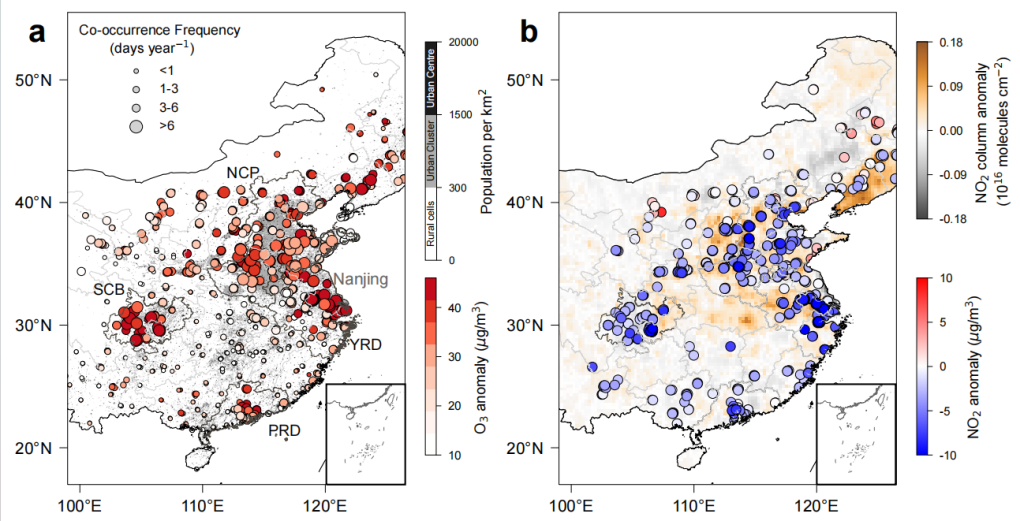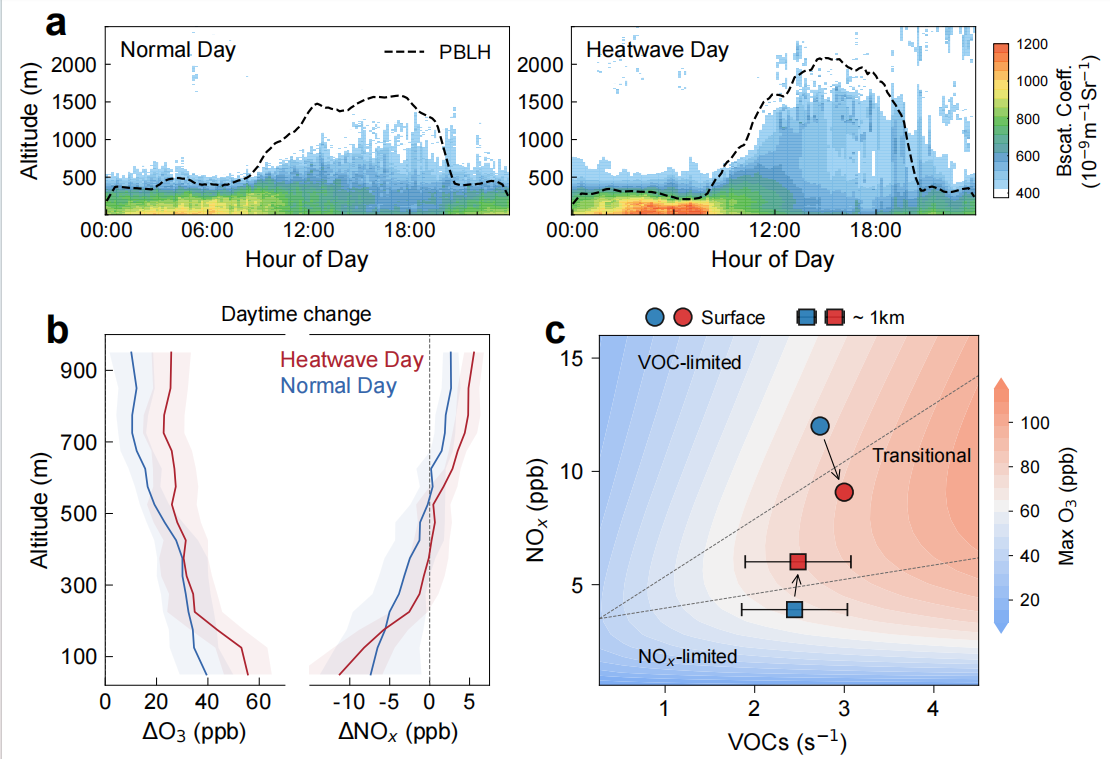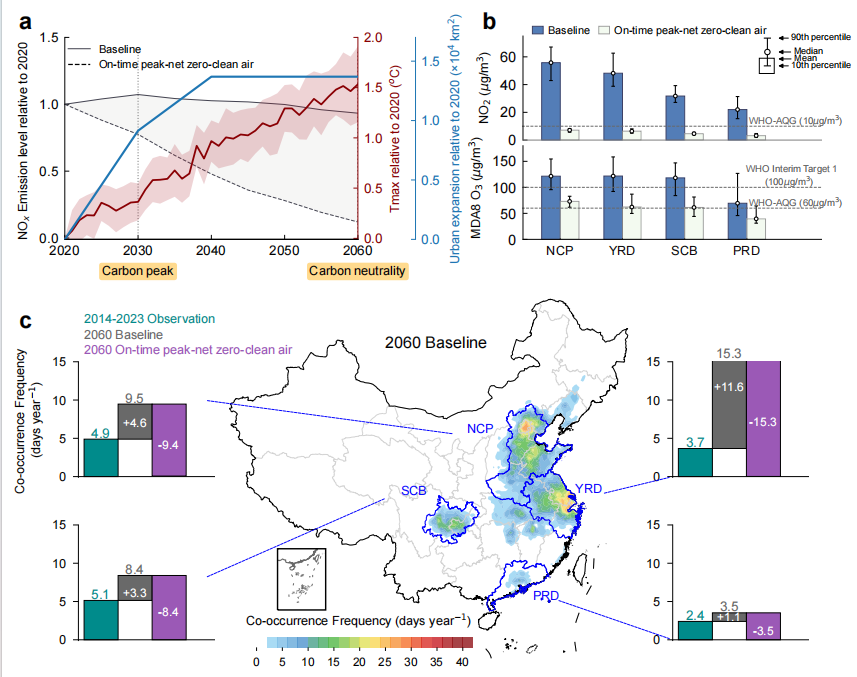Heatwaves are occurring frequently under the background of climate change, not only exerting seriously adverse impacts on ecosystem and agricultural production, but also leading to severe ozone (O3) pollution that threatens public health. In densely populated urban agglomerations, compound heat-ozone extremes have become one of the key challenges limiting urban livability and sustainable development. The formation of widespread, persistent O3 pollution during heatwaves is closely related to the complex physicochemical structure of the atmosphere. Effective prevention and response to such high-impact weather events require a systematic understanding of the formation mechanisms of compound heat-ozone extremes from the perspective of coupled atmospheric physicochemical processes. Recently, Professor Xin Huang's research team at School of Atmospheric Sciences, in collaboration with several domestic scholars, published an article titled "Urban meteorology-chemistry coupling in compound heat-ozone extremes" in Nature Cities, revealing the urban meteorology and chemistry coupling in compound heat-ozone extremes.
This study, integrating satellite remote sensing and ground-level air quality monitoring data, found that over the past decade in China, ozone concentrations generally increased during high-temperature periods. The proportion of monitoring sites with ozone exceedance rose from 11.5% to 26.6%, and the frequency of warm-season compound heat-ozone extremes exceeded 4.2 days per year, especially in densely populated urban agglomerations (Figure 1). During heatwaves, high temperatures and strong boundary layer diffusion cause abnormal vertical structures in the concentrations of major ozone precursors. Nitrogen oxides (NOx) increase at higher altitudes but significantly decrease near the surface, while near-surface volatile organic compounds (VOCs) concentrations are higher than usual.

Figure 1. Heatwave-associated ozone and nitrogen dioxide anomalies in the main city clusters of China.
Leveraging airship vertical measurements and meteorology-chemistry coupled modeling, the study found that significant changes in the vertical structure of precursors during heatwaves lead to shifts in ozone photochemical sensitivity. Typically, ozone photochemical production transitions with altitude from VOC-sensitive regions to NOx-sensitive regions. Under heatwave conditions, enhanced vertical mixing and increased biogenic VOC emissions alter the vertical distribution of precursors such as NOx and VOCs, accelerating ozone photochemical production rates near the surface and in the upper boundary layer, thereby exacerbating ozone pollution throughout the urban boundary layer (Figure 2). In the relatively dense emission background of China's urban agglomerations, NOx emission reductions during heatwaves more readily shift ozone photochemical production near the surface and upper boundary layer toward NOx sensitivity (advancing the transition threshold by about 10% compared to non-heatwave days), effectively mitigating urban ozone photochemical pollution.

Figure 2. Responses of urban boundary layer, ozone and nitrogen oxides to heatwaves.
Heatwaves are projected to become more severe under global warming. Under a moderate greenhouse gas emission scenario (SSP2-4.5), China’s surface daily maximum temperature is projected to rise by more than 1.5℃ around 2060, increasing the risk of extreme urban heat and ozone pollution. Using meteorology-chemistry coupled model simulations, this study evaluated the potential of emission reduction measures to alleviate urban ozone pollution under future climate change. The results show that under China's carbon neutrality goals by 2060, substantial pollutant reductions will shift ozone photochemical production toward NOx sensitivity, reducing ozone pollution during heatwaves by 41-47% in the Beijing-Tianjin-Hebei, Yangtze River Delta, Pearl River Delta, and Chengdu-Chongqing urban agglomerations (Figure 3). Although future heatwaves will intensify, proactive urban pollution control policies can significantly reduce the occurrence of compound heat-ozone extreme events, helping address the dual challenges of air pollution and climate change in cities.

Figure 3. Future co-occurrence of heat and ozone extremes during warm season.
PhD student Xueyu Zhou and Associate Professor Mengmeng Li from the School of Atmospheric Sciences at Nanjing University are co-first authors of the paper, with Professor Xin Huang as the corresponding author. Collaborators include Professor Aijun Ding and his team members from Nanjing University's School of Atmospheric Sciences, Researcher Yue Qin from the School of Environmental Science and Engineering at Peking University, Associate Researcher Guannan Geng from the School of Environment at Tsinghua University, among others. Nanjing University is the first and corresponding institution for the paper. This research was jointly funded by the National Natural Science Foundation of China (Grant No. 42293322) and the Key Research and Development Program of the Ministry of Science and Technology (Grant No. 2022YFC3701105).
Article link: Zhou, X., Li, M., Huang, X., Liu, T., Zhang, H., Qi, X., Wang, Z., Qin, Y., Geng, G., Wang, J., Chi, X., Ding., A., Urban meteorology–chemistry coupling in compound heat–ozone extremes. Nat Cities (2025). https://doi.org/10.1038/s44284-025-00302-1
